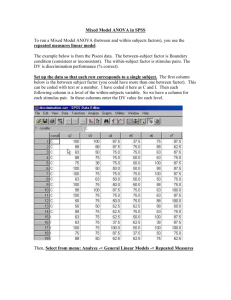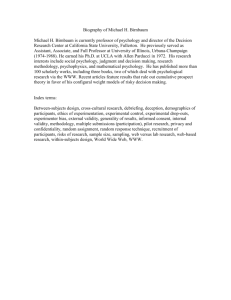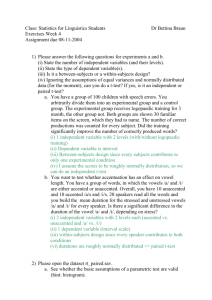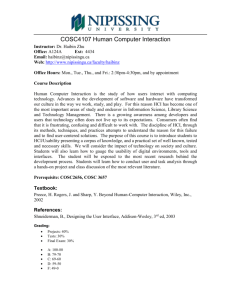ppt - Computer Science & Engineering
advertisement
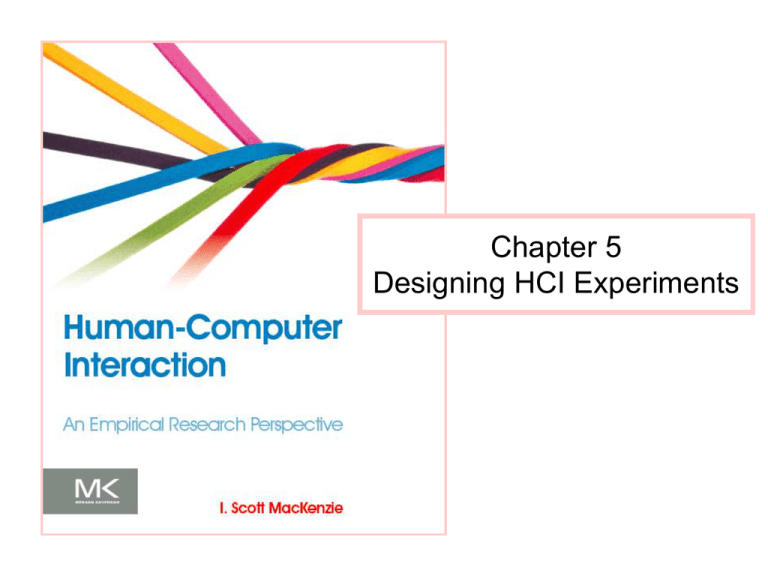
Chapter 5 Designing HCI Experiments Introduction • Learning to conduct and design an experiment is a skill required of all researchers in HCI • Experiment design is the process of deciding what variables to use, what tasks and procedures to use, how many participants to use and how to solicit them, and so on 2 Signal and Noise Metaphor • Signal and noise metaphor for experiment design: • Signal a variable of interest • Noise everything else (random influences) • Experiment design seeks to enhance the signal, while minimizing the noise 3 Methodology • Methodology is the way an experiment is designed and carried out • Methodology is critical: Science is method. Everything else is commentary.1 • What methodology? • Don’t just make it up because it seems reasonable • Follow standards for experiments with human participants (next slide) 1 This quote from Allen Newell was cited and elaborated on by Stuart Card in an invited talk at the ACM’s SIGCHI conference in Austin, Texas (May 10, 2012). 4 APA • American Psychological Society (APA) is the predominant organization promoting research in psychology – the improvement of research methods and conditions and the application of research findings (http://www.apa.org/) • Publication Manual of the APA1, first published in 1929, teaches about the writing process and, implicitly, about the methodology for experiments with human participants • Recommended by major journals in HCI 1 APA. (2010). Publication manual of the American Psychological Association (6th ed.). Washington, DC: APA. 5 Ethics Approval • Ethics approval is a crucial step that precedes every HCI experiment • HCI experiments involve humans, thus… Researchers must respect the safety, welfare, and dignity of human participants in their research and treat them equally and fairly.1 • Proposal submitted to ethics review committee • Criteria for approval: (see HCI:ERP for more detail) – – – – 1 research methodology risks or benefits the right not to participate, to terminate participation, etc. the right to anonymity and confidentiality http://www.yorku.ca/research/students/index.html 6 Students of CSE6329A • Please discuss your research project with Professor MacKenzie. Note that during the fall 2012 semester, there is ethics approval for research conducted under Professor MacKenzie’s supervision that falls within the scope of his NSERC research project (“Motor and Perceptual Optimization of User Interfaces”) 7 Getting Started With Experiment Design • Transitioning from the creative work in formulating and prototyping ideas to experimental research is a challenge • Begin with… What are the experimental variables? • Remember research questions: Can a task be performed more quickly with my new interface than with an existing interface? • Properly formed research questions inherently identify experimental variables (can you spot the independent variable and the dependent variable in the question above?) 8 Independent Variable • An independent variable (IV) is a circumstance or characteristic that is manipulated in an experiment to elicit a change in a human response while interacting with a computer. • “Independent” because it is independent of participant behavior (i.e., there is nothing a participant can do to influence an independent variable) • Examples: – interface, device, feedback mode, button layout, visual layout, age, gender, background noise, expertise, etc. • The terms independent variable and factor are synonymous 9 Test Conditions • An independent variable (IV) must have at least two levels • The levels, values, or settings for an IV are the test conditions • Name both the factor (IV) and its levels (test conditions): Factor (IV) Levels (test conditions ) Device mouse, trackball, joystick Feedback mode audio, tactile, none Task pointing, dragging Visualization 2D, 3D, animated Search interface Google, custom 10 Human Characteristics • Human characteristics are naturally occurring attributes • Examples: – Gender, age, height, weight, handedness, grip strength, finger width, visual acuity, personality trait, political viewpoint, first language, shoe size, etc. • They are legitimate independent variables, but they cannot be “manipulated” in the usual sense • Causal relationships are difficult to obtain due to unavoidable confounding variables 11 How Many IVs? • An experiment must have at least one independent variable • Possible to have 2, 3, or more IVs • But the number of “effects” increases rapidly with the size of the experiment: • Advice: Keep it simple (1 or 2 IVs, 3 at the most) • (see HCI:ERP for further discussion) 12 Dependent Variable • A dependent variable is a measured human behaviour (related to an aspect of the interaction involving an independent variable) • “Dependent” because it depends on what the participant does • Examples: – task completion time, speed, accuracy, error rate, throughput, target re-entries, task retries, presses of backspace, etc. • Dependent variables must be clearly defined – Research must be reproducible! 13 Unique DVs • Any observable, measurable behaviour is a legitimate dependent variable (provided it has the potential to reveal differences among the test conditions) • So, feel free to “roll your own” • Example: negative facial expressions1 – – – – 1 Application: user difficulty with mobile games Events logged included frowns, head shaking Counts used in ANOVA, etc. Clearly defined reproducible Duh, H. B.-L., Chen, V. H. H., & Tan, C. B. (2008). Playing different games on different phones: An empirical study on mobile gaming. Proceedings of MobileHCI 2008, 391-394, New York: ACM. 14 Data Collection • Obviously, the data for dependent variables must be collected in some manner • Ideally, engage the experiment software to log timestamps, key presses, button clicks, etc. • Planning and pilot testing important • Ensure conditions are identified, either in the filenames or in the data columns • Examples: (next two slides) 15 TextInputHuffman-P01-D99-B06-S01.sd1 16 TextInputHuffman-P01-D99-B06-S01.sd2 17 Control Variable • A control variable is a circumstance (not under investigation) that is kept constant while testing the effect of an independent variable • More control means the experiment is less generalizable (i.e., less applicable to other people and other situations) • Research question: Is there an effect of font color or background color on reading comprehension? – Independent variables: font color, background color – Dependent variable: comprehension test scores – Control variables • Font size (e.g., 12 point) • Font family (e.g., Times) • Ambient lighting (e.g., fluorescent, fixed intensity) • Etc. 18 Random Variable • A random variable is a circumstance that is allowed to vary randomly • More variability is introduced in the measures (that’s bad!), but the results are more generalizable (that’s good!) • Research question: Does user stance affect performance while playing Guitar Hero? – Independent variable: stance (standing, sitting) – Dependent variable: score on songs – Random variables • Prior experience playing a real musical instrument • Prior experience playing Guitar Hero • Amount of coffee consumed prior to testing • Etc. 19 Control vs. Random Variables • There is a trade-off which can be examined in terms of internal validity and external validity (see below) 20 Confounding Variable • A confounding variable is a circumstance that varies systematically with an independent variable • Should be considered, lest the results are misleading • Research question: In an eye tracking application, is there an effect of “camera distance” on task completion time? – Independent variable: Camera distance (near, far) • Near camera (A): inexpensive camera mounted on eye glasses • Far camera (B): expensive camera mounted above system display – Dependent variable: task completion time – But, “camera” is a confounding variable: camera A for the near setup, camera B for the far setup – Are the effects due to camera distance or to some aspect of the different setups? – (see HCI:ERP for the solution) 21 Fitts’ Law Example • Independent variables: – Index of difficulty (ID): 1, 2, 3, 4 bits – Amplitude: 16, 32, 64, 128 pixels • Note: ID = log2(2A / W) Experiment design (ID x Amplitude) Showing width (W) (See HCI:ERP for further discussion) W is a confounding variable (see below) Experiment design (W x Amplitude) 22 Experiment Task • Recall the definition of an independent variable: – a circumstance or characteristic that is manipulated in an experiment to elicit a change in a human response while interacting with a computer • The experiment task must “elicit a change” • Qualities of a good task: represent, discriminate – Represent activities people do with the interface • Improves external validity (but may compromise internal validity; see HCI:ERP for full discussion) – Discriminate among the test conditions • Increases likelihood of a statistically significant outcome (i.e., the sought-after “change” occurs) 23 Task Examples • Usually the task is self-evident (follows directly from the research idea) • Research idea a new graphical method for entering equations in a spreadsheet – Experiment task insert an equation using (a) the graphical method and (b) the conventional method • Research idea an auditory feedback technique for programming a GPS device – Experiment task program a destination location into a GPS device using (a) the auditory feedback method and (b) the conventional method 24 Knowledge-based Tasks • Most experiment tasks are performance-based or skillbased (e.g., inserting an equation, programming a destination location; see previous slide) • Sometimes the task is knowledge-based (e.g., “Use an Internet search interface to find the birth date of Albert Einstein.”) • In this case, participants become contaminated (in a sense) after the first run of task, since they have acquired the knowledge • Experimentally, this poses problems (beware!) • A creative approach is needed (e.g., for the other test condition, slightly change the task; “…of William Shakespeare”) 25 Procedure • The procedure encompasses everything that occurs with participants • The procedure includes the experiment task (obviously), but everything else as well… – Arriving, welcoming – Signing a consent form – Instructions given to participants about the experiment task (next slide) – Demonstration trials, practice trials – Rest breaks – Administering of a questionnaire or an interview 26 Instructions • Very important (best to prepare in advance; write out) • Often the goal in the experiment task is “to proceed as quickly and accurately as possible but at a pace that is comfortable” • Other instructions are fine, as per the goal of the experiment or the nature of the tasks, but… • Give the same instructions to all participants • If a participant asks for clarification, do not change the instructions in a way that may cause the participant to behave differently from the other participants 27 Participants • Researchers want experimental results to apply to people not actually tested – a population • Population examples: – Computer-literate adults, teenagers, children, people with certain disabilities, left-handed people, engineers, musicians, etc. • For results to apply generally to a population, the participants used in the experiment must be… – Members of the desired population – Selected at random from the population • True random sampling is rarely done (consider the number and location of people in the population examples above) • Some form of convenience sampling is typical 28 How Many Participants? • Too few experimental effects fail to achieve statistical significance • Too many statistical significance for effects of no practical value • The correct number… (drum roll please) – Use the same number of participants as used in similar research1 1 Martin, D. W. (2004). Doing psychology experiments (6th ed.). Pacific Grove, CA. Belmont, CA: Wadsworth. 29 Questionnaires • Questionnaires are used in most HCI experiments • Two purposes – Collect information about the participants • Demographics (gender, age, first language, handedness, visual acuity, etc.) • Prior experience with interfaces or interaction techniques related to the research – Solicit feedback, comments, impressions, suggestions, etc., about participants’ use of the experimental apparatus • Questionnaires, as an adjunct to experimental research, are usually brief 30 Information Questions • Questions constructed according to how the information will be used Ratio-scale data Ordinal-scale data Open-ended Closed 31 Participant Feedback • Using NASA Task Load Index (TLX): • ISO 9241-9: 32 Within-subjects, Between-subjects • Two ways to assign conditions to participants: – Within-subjects each participant is tested on each condition – Between-subjects each participant is tested on one condition only – Example: An IV with three test conditions (A, B, C): Within-subjects Between-subjects 33 Within-subjects, Between-subjects (2) • Within-subjects advantages – Fewer participants (easier to recruit, schedule, etc.) – Less “variation due to participants” – No need to balance groups (because there is only one group!) • Within-subjects disadvantage – Order effects (i.e., interference between conditions) • Between-subjects advantage – No order effects (i.e., no interference between conditions) • Between-subjects disadvantage – More participants (harder to recruit, schedule, etc.) – More “variation due to participants” – Need to balance groups (to ensure they are more or less the same) 34 Within-subjects, Between-subjects (3) • Sometimes… – A factor must be assigned within-subjects • Examples: Block, session (if learning is the IV) – A factor must be assigned between-subjects • Examples: gender, handedness – There is a choice • In this case, the balance tips to within-subjects (see previous slide) • With two factors, there are three possibilities: • both factors within-subjects • both factors between-subjects • one factor within-subjects + one factor between-subjects (this is a mixed design) 35 Order Effects, Counterbalancing • Only relevant for within-subjects factors • The issue: order effects (aka learning effects, practice effects, fatigue effects, sequence effects) • Order effects offset by counterbalancing: – Participants divided into groups – Test conditions are administered in a different order to each group – Order of administering test conditions uses a Latin square – Distinguishing property of a Latin square each condition occurs precisely once in each row and column (next slide) 36 Latin Squares 2x2 3x3 4x4 5x5 37 Balanced Latin Square • With a balanced Latin square, each condition precedes and follows each other condition an equal number of times • Only possible for even-orders • Top row pattern: A, B, n, C, n – 1, D, n – 2, … 4x4 6x6 38 Example • An experimenter seeks to determine if three editing methods (A, B, C) differ in the amount of time to do a common editing task: • Conditions are assigned within-subjects • Twelve participants are recruited and divided into three groups (4 participants/group) • Methods administered using a 3 3 Latin Square (2 slides back) • Results (next slide) 39 Results - Data Group effect is small Counterbalancing worked! 40 Results - Chart 41 Other Techniques • Instead of using a Latin square, all orders (n!) can be used; 3 3 case • Conditions can be randomized • Randomizing best if the tasks are brief and repeated often; examples (see below) Target size Movement direction Movement distance 42 Asymmetric Skill Transfer • A phenomenon known as asymmetric skill transfer sometimes occurs in within-subjects designs • Figures in next three slides demonstrate • They are presented in the slides without an explanation (to be discussed in class) • Please see HCI:ERP for complete details and discussion (including how to avoid asymmetric skill transfer) 43 LO Keyboard L+WP Keyboard = LO 44 45 46 Longitudinal Studies • Sometimes instead of “balancing out” learning effects, the research seeks to promote and investigate learning • If so, a longitudinal study is conducted • “Practice” is the IV • Participants are practiced over a prolonged period of time • Practice units: blocks, sessions, hours, days, etc. • Example on next slide 47 Longitudinal Study – Results1 1 MacKenzie, I. S., Kober, H., Smith, D., Jones, T., & Skepner, E. (2001). LetterWise: Prefix-based disambiguation for mobile text entry. Proceedings of the ACM Symposium on User Interface Software 48 and Technology - UIST 2001, 111-120, New York: ACM. The New vs. The Old • Sometimes a new technique will initially perform poorly in comparison to an established technique • A longitudinal study will determine if a crossover point occurs and, if so, after how much practice (see below) 49 Cost-Benefit Trade-offs • New, improved techniques sometimes languish • Evidently, the benefit in the new technique is insufficient to overcome the cost in learning it (see below) • Of course, there are other issues (see HCI:ERP for discussion) 50 Thank You 51
